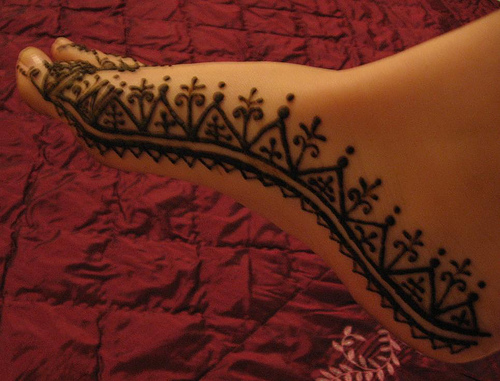FWP:
SETS == GESTURE; MUSHAIRAH; WORDPLAY
BONDAGE: {1,5}
HENNA:
{18,4}
For background see S. R. Faruqi's choices. For more on Ghalib's unpublished verses, see the discussion in {4,8x}.
Here's a textbook case of a mushairah-verse. Nothing is going on in it except wordplay-- but then, who would say that wordplay is nothing? (Of course, the 'natural poetry' people would, but that's their problem and not Ghalib's.)
The first line sets us up for something, but there's really no guessing what. Then (after the usual mushairah-performance delay) when we hear the second line, it's not until the last possible moment-- with the rhyme-word judaa -- that we suddenly get it all.
In a general way we have the juxtaposition of the beloved's feet and the lover's hands, unified by the excellently versatile verb baa;Ndhnaa -- which can refer (see the definition above) to the act of applying henna, and also to the act of binding or imprisoning (as a captive is bound), and also to the act of tying together (as hands are tied together). For more on henna, see {18,4}. (Zamin thinks the feet too are the lover's, but that doesn't seem very persuasive.)
But still, it's judaa that most strikingly energizes the verse (see the definition above). Just look at how every one of its possibilities becomes operative:
=The beloved 'binds' the lover's hands so that they're 'separated' from her feet.
=Paradoxically, she 'binds-together' his 'separated' hands.
=She binds his hands in a 'different' way from the way she 'binds' or applies the henna.
=The sight of her 'binding' henna on her feet paralyzes him, 'binding' his hands in a 'peculiar, extraordinary' way
Not bad for a little thirteen-word verse, huh? It has an amusing, enjoyable punch, and then we're ready to move on to the next one.

Asi:
'When my beloved puts henna on her feet, then she binds my hands separately.' In my view, in this verse there's nothing except that when she 'binds' henna onto her feet, then she 'binds' the hands. There is this single comparison, and no other pleasure.
== Asi, p. 166